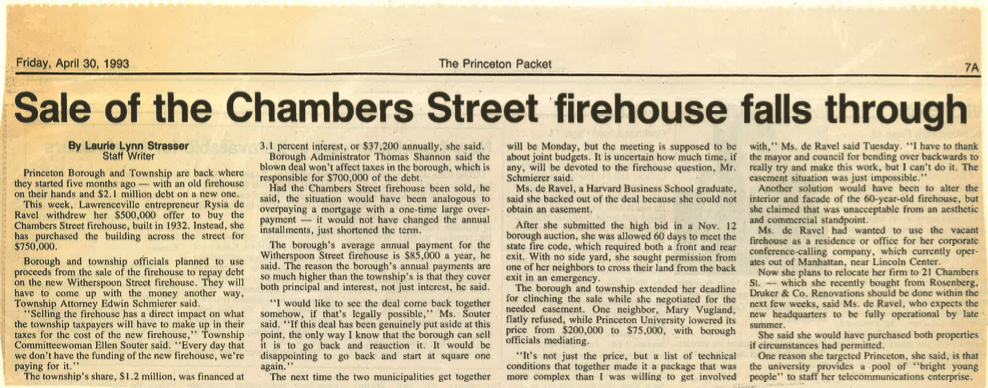
April 30, 1993
The Princeton Packet
Sale of the Chambers Street firehouse falls through
By Laurie Lynn Strasser
Staff Writer
Princeton Borough and Township are back where they started five months ago — with an old firehouse on their hands and $2.1 million debt on a new one. This week, Lawrenceville entrepreneur Rysia de Ravel withdrew her $500,000 offer to buy the Chambers Street firehouse, built in 1932. Instead, she has purchased the building across the street for $750,000.
Borough and township officials planned to use proceeds from the sale of the firehouse to repay debt on the new Witherspoon Street firehouse. They will have to come up with the money another way, Township Attorney Edwin Schmierer said.
“Selling the firehouse has a direct impact on what the township taxpayers will have to make up in their taxes for the cost of the new firehouse,” Township Committeewoman Ellen Souter said. “Every day that we don’t have the funding of the new firehouse, we’re paying for it.”
The township’s share, $1.2 million, was financed at 3.1 percent interest, or $37,200 annually, she said.
Borough Administrator Thomas Shannon said the blown deal won’t affect taxes in the borough, which is responsible for $700,000 of the debt.
Had the Chambers Street firehouse been sold, he said, the situation would have been analogous to overpaying a mortgage with a one-time large over-payment — it would not have changed the annual installments, just shortened the term.
The borough’s average annual payment for the Witherspoon Street firehouse is $85,000 a year, he said. The reason the borough’s annual payments are so much higher than the township’s is that they cover both principal and interest, not just interest, he said.
“I would like to see the deal come back together somehow, if that’s legally possible,” Ms. Souter said. “If this deal has been genuinely put aside at this point, the only way I know that the borough can sell it is to go back and reauction it. It would be disappointing to go back and start at square one again.”
The next time the two municipalities get together will be Monday, but the meeting is supposed to be about joint budgets. It is uncertain how much time, if any, will be devoted to the firehouse question, Mr. Schmierer said.
Ms. de Ravel, a Harvard Business School graduate, said she backed out of the deal because she could not obtain an easement.
After she submitted the high bid in a Nov. 12 borough auction, she was allowed 60 days to meet the state fire code, which required both a front and rear exit. With no side yard, she sought permission from one of her neighbors to cross their land from the back exit in an emergency.
The borough and township extended her deadline for clinching the sale while she negotiated for the needed easement. One neighbor, Mary Vugland, flatly refused, while Princeton University lowered its price from $200,000 to $75,000, with borough officials mediating.
“It’s not just the price, but a list of technical conditions that together made it a package that was more complex than I was willing to get involved with,” Ms. de Ravel said Tuesday. “I have to thank the mayor and council for bending over backwards to really try and make this work, but I can’t do it. The easement situation was just impossible.”
Another solution would have been to alter the interior and facade of the 60-year-old firehouse, but she claimed that was unacceptable from an aesthetic and commercial standpoint.
Ms. de Ravel had wanted to use the vacant firehouse as a residence or office for her corporate conference-calling company, which currently operates out of Manhattan, near Lincoln Center.
Now she plans to relocate her firm to 21 Chambers St. — which she recently bought from Rosenberg, Druker & Co. Renovations should be done within the next few weeks, said Ms. de Ravel, who expects the new headquarters to be fully operational by late summer.
She said she would have purchased both properties if circumstances had permitted.
One reason she targeted Princeton, she said, is that the university provides a pool of “bright young people” to staff her telecommunications enterprise.